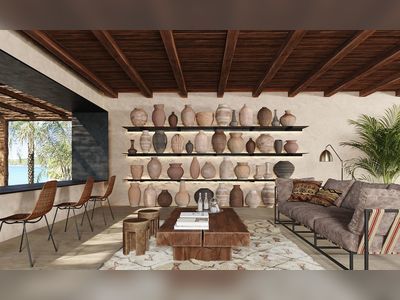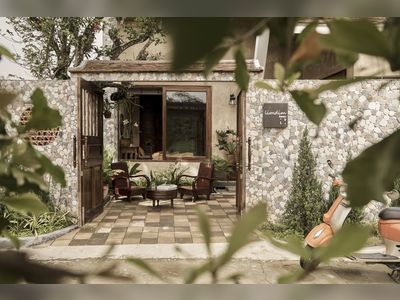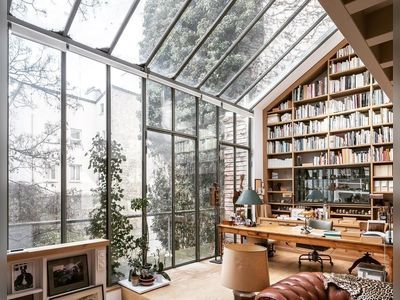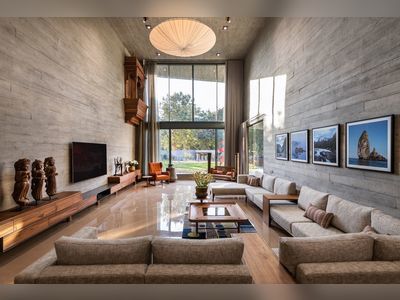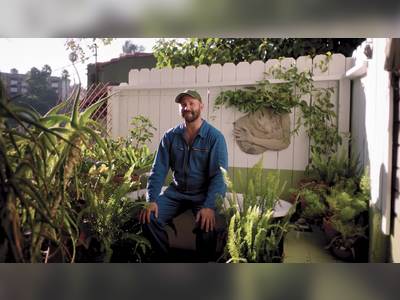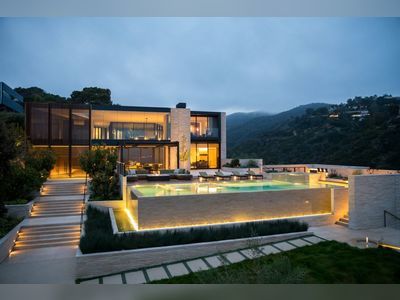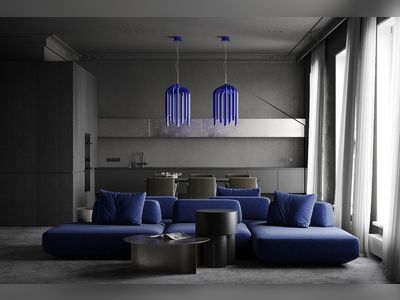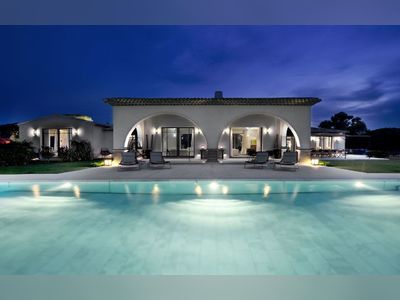In the past five years, as such salaries have been going off
the scale, it’s the ‘have yachts’ with money to burn who have helped
create a booming market for high-end luxury goods. In this market,
price is the crucial deciding factor. The higher the price, the more
attractive the product, with the added bonus that if you, Mr Gatsby,
can afford it, then it’s unlikely anyone else can.
Über luxury-living has sparked a sub-trend for limited edition design. One-off or ‘editioned’ works by living designers are promoted in art galleries and at auction houses. The inherent speculation that underpins the financial markets is the motive for many purchases. Almost $1m (£496 000) was achieved at auction in 2006 for the aluminium chaise longue prototype by Australian designer Marc Newson. Within six months, the anonymous buyer flipped the chaise by placing it with a dealer at $2.5m (£1.24m).
Does it matter that sales are driven by investment strategy? Perhaps
all that matters is that bespoke makers benefit. The trend for high-end
luxury allows specialist or moribund crafts and techniques to be
resuscitated, renewed and reintroduced to new audiences, and
new
materials and techniques to be explored. The handcrafted wallpaper of
Wouter Dolk is an example of a highly specialised technique, fetching
highly specialised prices. His medium – egg tempera on gesso – is
ancient and uncommon, but produces luminosity unachievable with oil
paint. Without the rise of 21st-century patrons, and in the absence of
adequate public sponsorship for the
arts, the market for makers such as Dolk would be limited.
That said, it is encouraging to know that the wallpapers of Dolk, Fromental, Linda Florence and Virgil Marti aren’t limited to their patrons. Each designer has work on display in public buildings – boutiques, restaurants and hotels – where the public can appreciate it. New wallpaper installations by Fromental are soon to be seen in the Mary Norton boutique in Charleston, US (the recently opened Mary Norton in Los Angeles already features Fromental Chinese Sparrow in a custom colourway), Fortnum & Mason in London, the new London Hotel in Los Angeles and the Langham Hotel in London (the last three in association with David Collins Studio). Fromental designs start at £125 per metre. Dolk’s papers begin at £750 per meter, excluding installation. Prices for Florence’s work vary according to the medium, but range from £600 per drop for her ‘chocolate gold on suede’ to £700 for a small wall of ‘grip flock’ and upwards for her laser-cut steel pieces. Marti’s work is priced on application to the Elizabeth Dee Gallery, New York.
Virgil Marti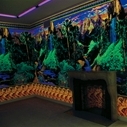
Panoramic landscape
designed by Virgil Marti
The wild card of the wallpaper world, Virgil Marti is an atypical artist, rather than a designer. His wallpapers are a smörgåsbord of references, from Baroque, Pop Art and Rococo to chinoiserie and cult films. Marti merges these elements to create wallpaper with the intensity and exposure range of a high-dynamic-range digital image, with especially subversive styling. Not for everyone is Mr Toad’s wild ride of imagery, hand-screened with DayGlo inks, tweaked in Photoshop, embellished with velvety black flock (to intensify the illusion of innerillumination) and brought to life with the black light bulbs beloved of 1960s college students and head shops. But Marti’s panoramic landscapes of palm trees, mountains, waterfalls and man-made monuments – bordered with a hot-rod, ankleburner, flame dado and magic mushrooms – have a loyal following.
Private collectors have snapped up Marti’s wallpapers, but the
public can experience his landscape paper in a ground-floor public
gallery at the 21c Museum Hotel in Louisville, Kentucky. Or visit the
men’s toilet at the Fabric Workshop in Philadelphia and do your
business facing Marti’s Bully paper.
It’s no coincidence that Marti arranged his 2004 installation at
the Elizabeth Dee Gallery like James McNeill Whistler’s Peacock room.
Whistler conveniently forgot to get permission before he transformed a
client’s sober leather-lined room with gold leaf, blue paint and gold
peacocks.
Linda Florence
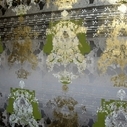
Wall of a home in Primrose
Hill, designed by Linda Florence
‘Flat patterns for flat surfaces’ – or so advocated Augustus Pugin, the strident 19th-century architect, designer and wallpaper reformer. What would he make of Linda Florence’s wallpaper designs? Florence has no allegiance to flat walls or paper, for that matter. An inquisitive innovator and materials junkie, she pushes beyond the confines of two dimensions and installs the outcome anywhere from walls to floors, interiors and exteriors. Some of her exquisite papers conform to the sizing and process of traditional wallpapers – she prints by hand and tones with as many as six hand-screened layers – but thereafter the designs veer into territory that might be described as Harajaku Girls meet Pugin Gothic.
Florence’s fixation on new materials and pushing the industry
into new ways of thinking inspired her to create ‘grip flock shapes’.
Fascinated by the flat, flexible, abrasive gripmaterial used on
skateboards (and before she located a supplier willing to provide
bespoke longgrip lengths), Florence bought multiple board lengths of
grip from a skate shop in London’s Covent Garden, printed it with black
flock for a contrast of rough and smooth, and then cut it into
standalone shapes. The grip shapes are fixed to the display surface in
as tight or as expansive a pattern as the designer and client agree on.
For Ted Baker shops in Richmond, Surrey, and Costa Mesa in the US,
Florence designed powdercoated, laser-cut steel shapes as a declaration
that wallpaper need be neither flat nor interiorsbased. Ted Baker Costa
Mesa competes for attention at the upscale South Coast Plaza with a
variety of high-end brands, including Tiffany, Gucci
and Prada.
In a nod towards the ever-clement southern- California weather,
Florence starts the show on the sidewalk, and extends her hoops, palm
trees, roses and swoops from the interior walls to the exterior, where
the collective size (each shape is up to 1m wide) of the design can be
seen from a distance. The three-dimensional effect is exaggerated by
pegging each shape so it stands proud of the wall, with surfaces
finish-dipped in either gold or black.
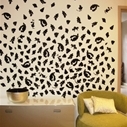
Grip flock shapes designed
by Linda Florence
For the Ted Baker shop in Richmond, the lasercut steel is shaped to a traditional wallpaper-drop panel size, and ceiling-mounted in display windows and in front of walls. The filigree pattern allows the window drops to cast interior patterns when the sun shines at just the right angle, giving Ted Baker and his clientele two bespoke ‘wallpapers’ for the price of one.
Wouter Dolk
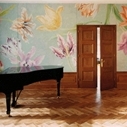
A music room in Cologne,
Germany, decorated with flower
wallpaper designed
Somewhere in New York’s Manhattan, a gentleman awakes to perpetual springtime. Giant blue hyacinths, tulips and violets carpet his bedroom walls. Late spring blooms – blue dahlias and blue roses – paper his office. True-blue flowers are rare in nature, but rarer still are wallpapers created by Wouter Dolk. His wallpaper is – like all Dolk’s hand-made, bespoke paper – a labour-intensive, highly specialised creation.
Despite the enormous scale of many of his patterns, Dolk starts
small. After an initial site survey, he builds a 1:10 scale miniature.
Doors,
windows, corners and furniture are plotted, and Dolk’s
preliminary drawings are adapted to fit elevation vagaries or layout
problems. Next, industrial, acid-free packing paper is primed with
multiple (as many as 30) layers of gesso. Each layer takes three days
to dry. The more layers, the more visual depth to the finish, and the
greater the sense of trompe l’oeil magic. The pattern is then
transferred to the gessoed paper and handcoloured by Dolk with egg
tempera. The completed work is backed with fabric, frame-mounted and
installed.
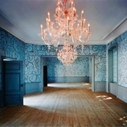
Benrath Castle in Dusseldorf,
Germany, decorated with wallpaper
designed
Don’t think about making an impulse purchase. Dolk’s method is
deliberate, his materials unconventional and his output limited. Like
many artists, he controls output by working without assistants. A
commission can take up to a year to complete, but for patient (and
wealthy) commissioners the reward is un coup de foudre – love at first
sight. Dolk’s wallpapers aren’t all hidden in private residences. His
paper for the penthouse suite of the Art Deco style Hotel Victor in
Miami, US, takes a tropical cue and displays an eclectic flock of
orange
birds roosting in grisaille branches. Visit the famed Autostadt in
Germany, and stacked rows of butterflies on Dolk’s paper greet
visitors. The butterflies subtly mimic the apparent uniformity of the
cars displayed in the 20-storey glass towers. Each butterfly may appear
the same, but each is unique, just like Dolk’s bespoke creations.
Fromental
Steve Wynn isn’t a successful hotelier
for nothing. He knows stratification – price points for the haves and
the have-nots – is vital for sustainable success. The Wynn Las Vegas
Resort has selfcontained villas to shield celebrities from paparazzi,
haves, and have-nots. The B-list gets 650m2 villas. A-listers luxuriate
in 930m2 minipalaces, with bedrooms decorated with chocolate mint-chip
Fromental wallpaper, hand-embroidered with stripes and butterflies.
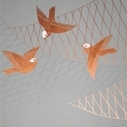
Detail of Birds and Nets,
from the 20th Century Collection
The beauty and quality of Fromental wallpapers is apparent at first glance, but closer study provides a further reward. Hand-painted and handembroidered in China, to designs created in London by the studio of Tim Butcher and Lizzie Deshayes, Fromental papers have the sublime subtlety of a venerable luxury brand (although the company was founded in 2005), while avoiding the ‘look at me’ embellishments that stud many highend products.
The design, not the designer, is the focus. Painting and part-
or fully-embroidering on silkbacked panels, artisans use as many as 14
shades of each thread to create the non-repeating patterns, and spend
up to 600 hours embroidering each drop. In the same manner that Wynn
stratifies product to widen consumer access, so too are Fromental
papers tier-priced, from the painted papers to part-embroidered to
fully embroidered.
If you have the desire, but not the recognition to stay in a Wynn villa, experience Fromental embroidered, standalone, silk wallpaper panels in the Gordon Ramsay restaurant at the London NYC Hotel, Manhattan. Importing Blighty to the Big Apple, the panels interpret quintessential features of English life – landscape, architecture and Hyde Park.
Embroidered chinoiserie Fromental wallpaper decorates a private
dining room at the London NYC, but with a twist. A blood olive
colourway flips expectations of chinoiserie, and completely modernises
the traditional. In London, the Blandford Street Restaurant and China
Tang at the Dorchester Hotel are lined with Fromental papers too.
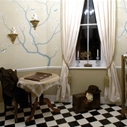
A room in France decorated
with the Chinese Sparrows design
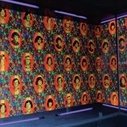
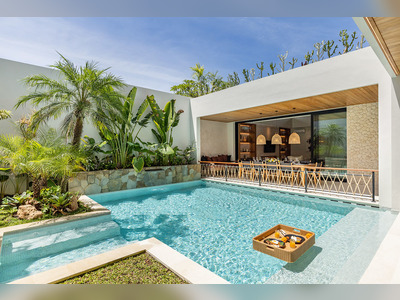
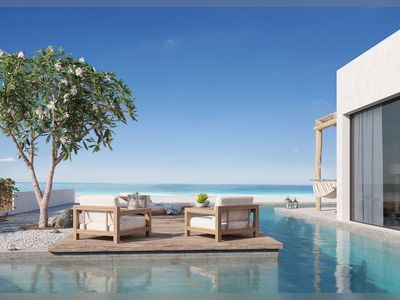
![A Tranquil Jungle House That Incorporates Japanese Ethos [Video]](/images/22/08/b-2ennetkmmnn_t.jpg)
